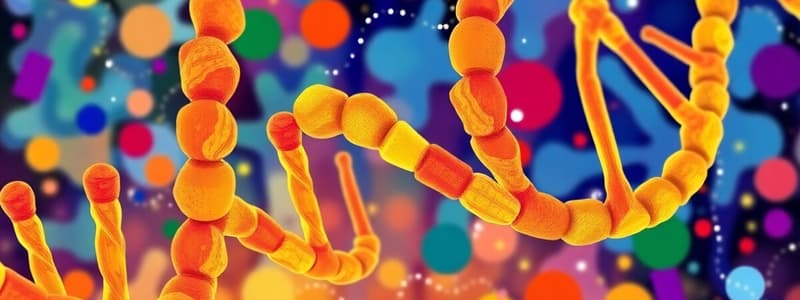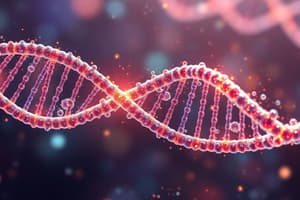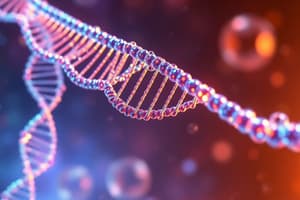Podcast
Questions and Answers
What is the primary purpose of the Polymerase Chain Reaction (PCR)?
What is the primary purpose of the Polymerase Chain Reaction (PCR)?
- To amplify a specific DNA sequence (correct)
- To separate RNA based on size
- To cut DNA at specific sequences
- To visualize proteins in a gel
Which technique is used to detect specific DNA sequences in a sample?
Which technique is used to detect specific DNA sequences in a sample?
- Northern blotting
- Restriction enzyme digestion
- Reverse transcription
- Southern blotting (correct)
What process is essential for quantifying RNA levels in a sample?
What process is essential for quantifying RNA levels in a sample?
- DNA cloning
- Gel electrophoresis
- Reverse transcription polymerase chain reaction (RT-PCR) (correct)
- Northern blotting
What component is crucial for the PCR process?
What component is crucial for the PCR process?
Which technique involves the insertion of a DNA fragment into a vector?
Which technique involves the insertion of a DNA fragment into a vector?
What does gel electrophoresis primarily utilize for separation of molecules?
What does gel electrophoresis primarily utilize for separation of molecules?
What is the main function of restriction enzymes in molecular biology?
What is the main function of restriction enzymes in molecular biology?
What is needed for visualizing results in Southern blotting?
What is needed for visualizing results in Southern blotting?
What is the primary purpose of Western blotting in protein analysis?
What is the primary purpose of Western blotting in protein analysis?
Which technique utilizes antigen-antibody binding to measure protein concentration?
Which technique utilizes antigen-antibody binding to measure protein concentration?
What is a primary advantage of CRISPR-Cas9 over other gene editing techniques?
What is a primary advantage of CRISPR-Cas9 over other gene editing techniques?
Which technique allows for simultaneous analysis of expression levels of thousands of genes?
Which technique allows for simultaneous analysis of expression levels of thousands of genes?
Which step is crucial in sample preparation to ensure the validity of molecular biology results?
Which step is crucial in sample preparation to ensure the validity of molecular biology results?
What is the primary function of chromatin immunoprecipitation (ChIP)?
What is the primary function of chromatin immunoprecipitation (ChIP)?
Which method is primarily used for isolating specific proteins based on their interaction with other molecules?
Which method is primarily used for isolating specific proteins based on their interaction with other molecules?
During protein extraction, which factor is important in choosing the method used?
During protein extraction, which factor is important in choosing the method used?
Flashcards
What is PCR?
What is PCR?
A powerful technique used to amplify specific DNA sequences. It involves numerous cycles of heating and cooling to denature and copy the DNA.
What is the role of primers in PCR?
What is the role of primers in PCR?
Utilizes specific primers that are complementary to the target DNA sequence, facilitating the PCR amplification process.
What is gel electrophoresis?
What is gel electrophoresis?
A method for separating DNA, RNA, or proteins based on their size and electric charge.
Define DNA cloning.
Define DNA cloning.
Signup and view all the flashcards
What are restriction enzymes?
What are restriction enzymes?
Signup and view all the flashcards
What is Northern blotting?
What is Northern blotting?
Signup and view all the flashcards
Explain reverse transcription polymerase chain reaction (RT-PCR).
Explain reverse transcription polymerase chain reaction (RT-PCR).
Signup and view all the flashcards
What is RNA extraction?
What is RNA extraction?
Signup and view all the flashcards
What is Western blotting?
What is Western blotting?
Signup and view all the flashcards
What is ELISA?
What is ELISA?
Signup and view all the flashcards
What is CRISPR-Cas9?
What is CRISPR-Cas9?
Signup and view all the flashcards
What is DNA sequencing?
What is DNA sequencing?
Signup and view all the flashcards
What is microarray analysis?
What is microarray analysis?
Signup and view all the flashcards
What is Chromatin Immunoprecipitation (ChIP)?
What is Chromatin Immunoprecipitation (ChIP)?
Signup and view all the flashcards
What is Affinity purification?
What is Affinity purification?
Signup and view all the flashcards
Why is sample preparation crucial in molecular biology?
Why is sample preparation crucial in molecular biology?
Signup and view all the flashcards
Study Notes
Introduction to Molecular Biology Techniques
- Molecular biology techniques are crucial for understanding biological processes at the molecular level.
- These techniques involve manipulating and analyzing DNA, RNA, and proteins.
- The ability to isolate, purify, and manipulate these biomolecules allows researchers to study gene function, protein structure, and the development of novel therapies.
DNA Manipulation Techniques
- Polymerase Chain Reaction (PCR): A method for amplifying a specific DNA sequence.
- It involves repeated cycles of heating and cooling to denature and replicate the DNA.
- This technique is essential for cloning genes, studying gene expression, and diagnosing genetic diseases.
- Requires specific primers that are complementary to the target DNA sequence.
- Gel electrophoresis: A technique for separating DNA, RNA, or proteins based on their size and charge.
- Samples are loaded into wells of a gel matrix (e.g., agarose or polyacrylamide).
- An electric field is applied, causing the molecules to migrate through the gel.
- Smaller molecules move faster than larger ones, allowing for separation and visualization.
- DNA cloning: A method for creating multiple copies of a particular DNA fragment.
- A DNA fragment of interest is inserted into a vector (e.g., plasmid).
- The vector is introduced into a host organism (e.g., bacteria), where it replicates.
- This allows for large-scale production of the target DNA.
- Restriction enzyme digestion: Enzymes that cut DNA at specific sequences.
- Used to isolate specific DNA fragments.
- Crucial in recombinant DNA technologies.
- Southern blotting: A technique for detecting specific DNA sequences in a sample of DNA.
- DNA is separated by gel electrophoresis and transferred to a membrane.
- A labeled probe that is complementary to the target DNA sequence is used for detection.
- Visualized by autoradiography or other detection methods.
RNA Techniques
- Reverse transcription polymerase chain reaction (RT-PCR): A technique for quantifying RNA levels.
- RNA is reverse transcribed into complementary DNA (cDNA).
- cDNA is then amplified by PCR.
- Quantifies the amount of a specific RNA molecule.
- RNA extraction: Isolating RNA from cells or tissues.
- Various methods exist, often depending on the desired RNA type (e.g., Total RNA, mRNA).
- Critical to downstream RNA analysis techniques.
- Northern blotting: Similar to Southern blotting, but used to detect specific RNA sequences.
- RNA is separated by gel electrophoresis and transferred to a membrane.
- RNA is visualized using labeled probes complementary to the target RNA sequence.
Protein Techniques
- Protein extraction: Isolating proteins from cells or tissues.
- Different methods exist, depending on cellular components and the desired proteins.
- Used to study protein function and interactions.
- Western blotting: Detecting specific proteins in a sample.
- Proteins are separated by gel electrophoresis (SDS-PAGE).
- Proteins are transferred to a membrane.
- Detection is performed using antibodies specific to the protein of interest.
- Often used to study protein expression levels.
- Enzyme-linked immunosorbent assay (ELISA): A technique used to measure the concentration of a specific protein.
- Based on the principle of antigen-antibody binding.
- One of the most common techniques for quantifying various proteins.
Gene Editing Techniques
- CRISPR-Cas9: A revolutionary gene-editing tool.
- Allows for precise modification of DNA sequences.
- Enables researchers to study gene function and develop potential therapies.
- This technology is versatile and precise relative to other gene editing techniques.
Other Important Techniques
- DNA sequencing: Determining the precise order of nucleotides in a DNA molecule.
- Different sequencing methods exist (e.g., Sanger sequencing, next-generation sequencing).
- Crucial for understanding genetic variations and for various applications.
- Microarray analysis: A high-throughput technique for studying gene expression.
- Allows for simultaneous analysis of the expression of thousands of genes.
- Chromatin immunoprecipitation (ChIP): Used for determining the binding of proteins to specific regions in the genome.
- Enables the identification of regulatory factors related to specific genes.
- Affinity purification: Allows for isolation of specific proteins based on their binding properties.
- Can be used to identify and isolate proteins that interact with a particular protein of interest, for example.
Sample Preparation
- Sample preparation is a critical step before applying any molecular biology technique. Appropriate sample handling during preparation is essential to the validity of any results.
- Variables such as cell lysis, protein denaturation, and RNA integrity play critical roles in the quality and successful outcome of various molecular biology procedures.
Studying That Suits You
Use AI to generate personalized quizzes and flashcards to suit your learning preferences.




